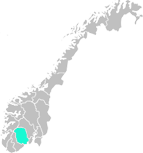



The museum has buildings and artefacts dated back to the middle ages, and aims to bring to life the colourful history of Fyresdal.
Folkestadbyen - The People's Town
In the second half of the 1800’s Fyresdal grew into a small town: Folkestadbyen. Øystad is an original cluster of buildings from this period. Here you also find Fyresdal Tourist Information Office.
Another feature of the museum is the town’s original local bakery, renovated and restored to tip top condition 1920’s style.
Burial mounds
For hundreds of years the Øyskogen was regarded as sacred ground. Here we find one of Norway’s most beautiful burial grounds from the age of migration. No doubt this has been an important place of worship in the time of written history.
Building a burial mound was an important act of religion and politics. As a burial site the mound represents a vision of life after death with a distinction between life and death far less absolute than we imagine today. The mound was a symbol of power, not only to the person buried there, but also to the family and village.
As people at the time believed they could achieve contact with their ancestors and the gods through blóts (sacrifice to the Norse gods), the mound was also, in a wider sense, a place of worship.
Building a burial mound demanded a great deal of resources, and therefor often only one person from each generation would be buried in a mound.
The burial mounds in Fyresdal are believed to be built in the late Iron Age, 400-600 AD, which means that they might be 1600 years old.
There is no guide at the museum, but guided tours for groups of 10 persons or more can be submitted from West Telemark Museum: booking@vtm.no.
Group guidings are also possible off-season.
| Ticket Type | Ticket Tariff |
|---|---|
| Children (0-16 years) | Free |
| Adults (from 16 years) | Free |
| Groups min. 10 pers. | NOK80.00 1 person |
Prices are subject to change.
| Season (25 June 2025 - 15 Aug 2025) | ||
|---|---|---|
| Day | Times | |
* General Opening Text
Folkestadbyen- The town of Folkestad.
In the 1870s, a centre for commerce and crafts…
The Russvass dam, which has been a central element in timber floating in Fardøl since…
Våmur Viewpoint in Telemark, where steep mountain sides meet majestic Fyresvatn. Enjoy…
Horseback riding, horse and carriage driving, hunting and fishing, orienteering,…